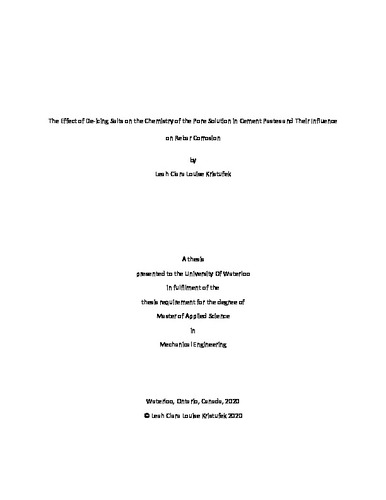UWSpace will be migrating to a new version of its software from July 29th to August 1st. UWSpace will be offline for all UW community members during this time.
The Effect of De-icing Salts on the Chemistry of the Pore Solution in Cement Pastes and Their Influence on Rebar Corrosion
| dc.contributor.author | Kristufek, Leah | |
| dc.date.accessioned | 2020-01-15 18:35:16 (GMT) | |
| dc.date.available | 2020-01-15 18:35:16 (GMT) | |
| dc.date.issued | 2020-01-15 | |
| dc.date.submitted | 2020-01-10 | |
| dc.identifier.uri | http://hdl.handle.net/10012/15468 | |
| dc.description.abstract | Anti-icing and de-icing salts are an important tool used to increase traction and prevent the formation of black ice. Municipalities may choose to use any of a variety of salts including NaCl, CaCl2 and MgCl2. While all salts depress the freezing point of water, CaCl2 and MgCl2 are effective at lower temperatures making their use more common in Northern Ontario. The use of de-icing and anti-icing salts results in greater traction for vehicles and pedestrians while resulting in increased aesthetics when salt rather than sand is used. These benefits have prompted more northern Canadian municipalities to try using CaCl2 and MgCl2 salts when previously sand and gravel have been used. Current research into the effects of road salts on rebar corrosion and concrete focuses mainly on the effects of NaCl salts despite some researchers indicating that CaCl2 and MgCl2 impact concrete and rebar corrosion differently. It is of interest to better understand the hydration products formed in cement exposed to the different salt types since damage to cements can reduce the effective concrete cover depth over rebar. In this research pore solution expression has been used to investigate how different amounts of admixed NaCl, CaCl2 and MgCl2 impact the composition of pore solution from general use Portland cement and by extension the composition of the solid hydration products. These tests indicate that expressed pore solution from cement paste with admixed NaCl contained significantly more sulphate and chloride than pore solution from pastes which contained CaCl2 or MgCl2. The pH of pore solutions from pastes containing CaCl2 or MgCl2 also decreased significantly compared to pastes with an equivalent amount of NaCl. Using the expressed pore solution information about changes in the elemental composition synthetic pore solutions can be designed which closer mimic cement exposed to these salts. In this research synthetic pore solutions were prepared from laboratory grade NaOH, KOH, Ca(OH)2 and CaSO4 as well as admixed NaCl, CaCl2 or MgCl2 to investigate rebar corrosion using electrochemical testing techniques. In addition to synthetic pore solutions replicating the pore solution in pastes containing the three salts other synthetic pore solutions from literature were chosen representing varying elemental compositions and pH values between 12.6 and 13.8. The environment inside cement without salt is protective for reinforcing bars. The pH of expressed pore solution without admixed salts was found to be approximately 13.3. | en |
| dc.language.iso | en | en |
| dc.publisher | University of Waterloo | en |
| dc.subject | deicing | en |
| dc.subject | anti-icing | en |
| dc.subject | MgCl2 | en |
| dc.subject | CaCl2 | en |
| dc.subject | NaCl | en |
| dc.subject | rebar corrosion | en |
| dc.subject | cement | en |
| dc.subject | concrete | en |
| dc.subject | reinforcement corrosion | en |
| dc.subject | carbon steel | en |
| dc.subject | black steel | en |
| dc.subject | pore solution | en |
| dc.subject | synthetic pore solution | en |
| dc.subject | LPR | en |
| dc.subject | electrochemical testing | en |
| dc.subject | xrd | en |
| dc.subject | cement hydration | en |
| dc.subject | mill scale | en |
| dc.title | The Effect of De-icing Salts on the Chemistry of the Pore Solution in Cement Pastes and Their Influence on Rebar Corrosion | en |
| dc.type | Master Thesis | en |
| dc.pending | false | |
| uws-etd.degree.department | Mechanical and Mechatronics Engineering | en |
| uws-etd.degree.discipline | Mechanical Engineering | en |
| uws-etd.degree.grantor | University of Waterloo | en |
| uws-etd.degree | Master of Applied Science | en |
| uws.contributor.advisor | Hansson, Carolyn | |
| uws.contributor.affiliation1 | Faculty of Engineering | en |
| uws.published.city | Waterloo | en |
| uws.published.country | Canada | en |
| uws.published.province | Ontario | en |
| uws.typeOfResource | Text | en |
| uws.peerReviewStatus | Unreviewed | en |
| uws.scholarLevel | Graduate | en |

